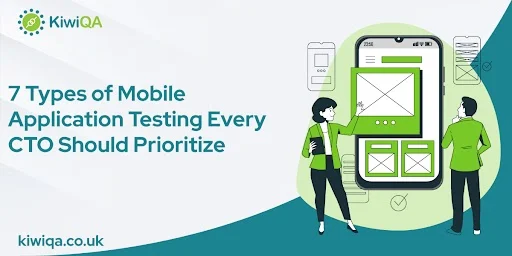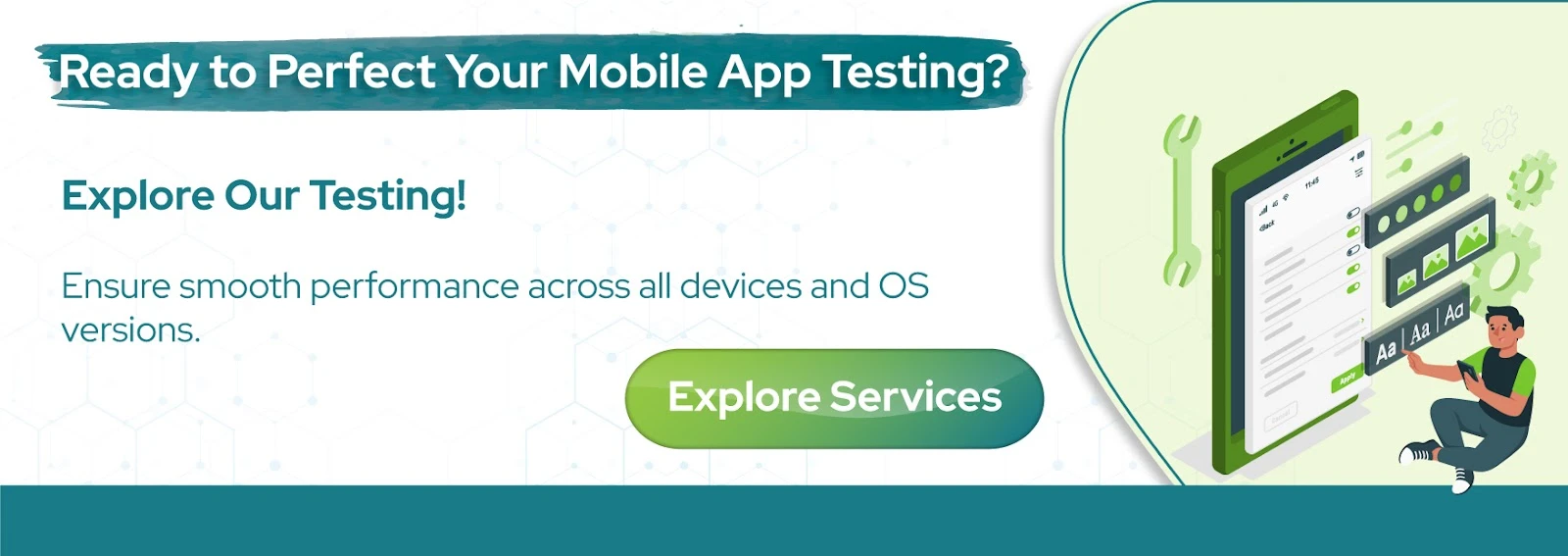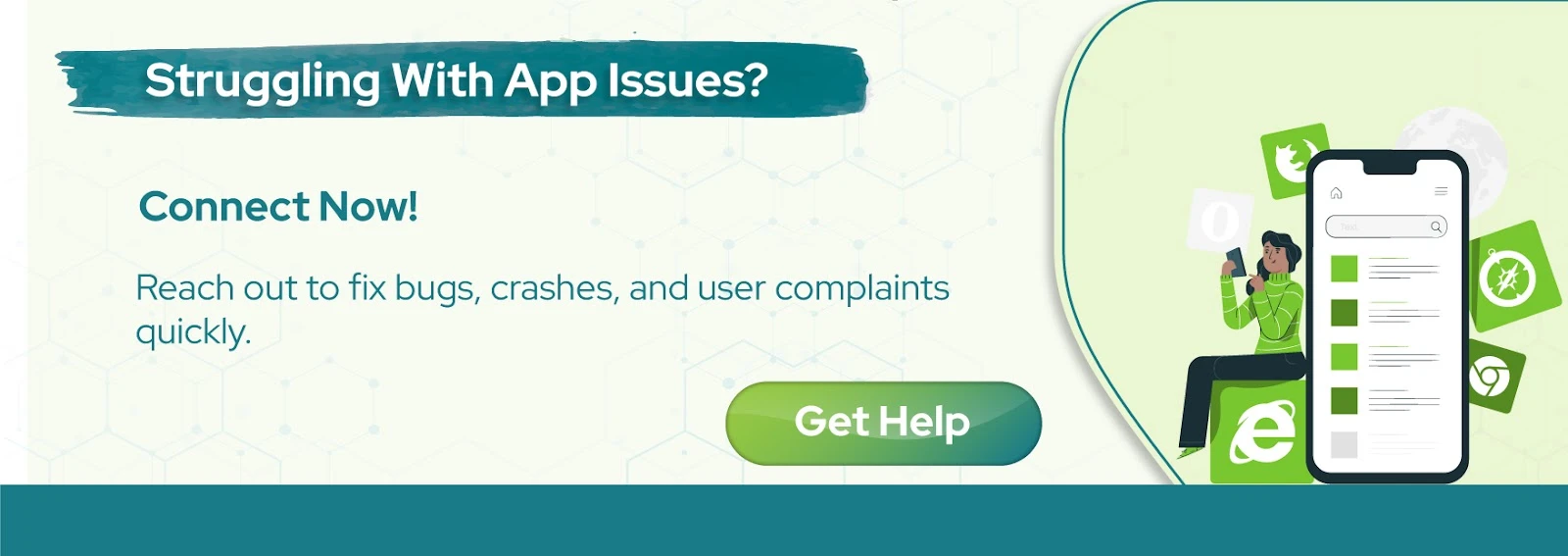Mobile QA testing is now more crucial than ever as technology and its influence on our daily lives continue to grow. Our environment is increasingly dominated by mobile gadgets, which accompany us everywhere. Moreover, 85% of the world’s population, or 6.92 billion people, use smartphones. For this reason, mobile quality assurance testing is a good choice. There are about five million smartphone applications available currently. As a result, the market for mobile apps is saturated and fiercely competitive. 71% of consumers remove apps because they crash.
Strict testing is done on mobile applications to make sure they meet and surpass user, usability, and quality standards. To find flaws, improve performance, and provide a flawless user experience, mobile apps must be assessed and validated across a range of platforms, devices, and operating systems. To guarantee software quality, lower risks, and enhance overall company results, CTOs should support an extensive mobile application testing services approach.
Better client experiences, a quicker time to market, and lower production bug repair costs are all facilitated by a strong testing approach that finds and addresses problems early. Better resource allocation is also made possible, data-driven decision-making is facilitated, and regulatory compliance is guaranteed. Here, check the different types of application testing.
➥ Functional Testing
❒ Purpose
A bad mobile experience causes 65% of consumers to build a bad reputation for any brand. During this mobile application testing service, testers run through every feature of the product using pre-written test scripts to ensure that it operates as intended in a localized setting. Verification that the localized product is compatible with different OS and third-party goods is frequently an element of functional testing.
In general, functional testing necessitates complete product awareness and a solid command of the target language. Among the most significant issues with functional testing might be: Missing or incorrect windows, visuals, and user interface elements, Errors caused by installing the localized program on a localized operating system, incorrect error messages, and localization flaws that might result in software crashes.
❒ What It Covers?
● Core features and business logic
Functional mobile app testing services verify that the key features of the application are operating as intended and appropriately. Validating the app’s business logic, which determines how it handles various scenarios and processes data, is another goal of functional testing.
● UI functionality (buttons, forms, navigation)
This involves ensuring that the UI is aesthetically consistent and intuitive across various browsers and devices, as well as verifying the operation of features such as buttons, text fields, menus, and other interactive components.
● API integrations
Verifying that the API endpoints properly and consistently carry out their intended activities in accordance with requirements is the main goal of functional testing of API integrations. To make sure the API operates as intended, this involves checking response timings, status codes, input variables, output data, and error handling.
❒ Why It Matters to CTOs?
Every CTO of a mobile testing company must know that this kind of mobile testing makes sure that all of an application’s features operate as planned and adhere to preset standards. Functional testing often concentrates on the features that establish the app’s user flows. This approach uses black-box testing methods to assess a system. Being a CTO, you must know that approaching functional mobile app testing takes a business closer to achieving user satisfaction & accelerating app usability.
➥ Performance Testing
❒ Purpose
Performance testing by an app testing company is necessary to measure your mobile app’s performance in the expected workload scenario & to limit the performance errors. Performance testing aims to determine whether the app responds quickly or takes time. Performance is crucial because if the application is malfunctioning, the chances are higher that the users will either uninstall and abandon your app or shift to a competitor’s application.
Measuring the scalability, speed & responsiveness of the application is necessary to build user trust and enhance app usability. Through performance testing, app owners can measure the performance of the network, device, & server/API.
❒ What It Covers?
Load testing: How the app handles concurrent users
A crucial component of performance testing, load testing explicitly evaluates how a system performs under expected user load scenarios. It seeks to locate possible performance problems and delays that could appear when a particular number of users are handled by the system.
Stress testing: Performance under peak load
A crucial component of performance types of application testing, stress testing evaluates how a system performs in harsh environments and outside its typical operating range. This makes it easier to guarantee the system’s resilience, stability, and capacity to manage unforeseen heavy loads or resource limitations.
Stability over prolonged use
Evaluation of an app’s stability and performance under extended, continuous usage is the main goal of performance testing, especially endurance or soak testing. This kind of testing seeks to find possible problems that could only show up over time, such as memory leaks and performance deterioration.
❒ Why It Matters to CTOs?
Performance mobile app testing service matters to CTOs since it helps businesses to avoid slow downloads & crashes that ultimately impact their brand reputation. By approaching this testing, businesses can let the users know that the app is smooth, reliable, optimize the resource classification & avoid risks. Through proactive identification & resolving performance issues, CTOs can accelerate customer satisfaction, boost organizational outcomes & set a competitive edge.
Also Read :- Top-Rated Mobile Application Testing Company in UK for Scalable App Solutions
➥ Usability Testing
❒ Purpose
The purpose of usability mobile application testing service is to evaluate a mobile application’s usability, including its navigation, simplicity of use, and flexible controls. In essence, testers employ actual consumers on actual devices to do this kind of mobile testing. A few test cases or activities to complete on the program are provided to users. This enhances the application’s usability and helps testers comprehend the preferences of the target market.
❒ What It Covers?
Ease of navigation
The focus of usability testing for ease of navigation is on how simple it is for users to navigate a website or application and locate the information they need.
Accessibility for users with disabilities
This involves determining whether users with psychological or visual impairments can utilize the product and finish tasks efficiently.
Overall satisfaction and intuitiveness
Usability mobile application testing types focus on overall pleasure and intuitiveness to assess a product’s ease of learning, usage, and enjoyment. It evaluates users’ overall happiness with the experience as well as their ability to do tasks successfully and efficiently.
❒ Why It Matters to CTOs?
CTOs care about usability testing because it guarantees that products are efficient, user-friendly, and in line with business objectives, which eventually boosts user happiness, lowers development costs, and gives a company a greater competitive edge. CTOs may promote innovation, reduce product launch risks, and maximize resource allocation by concentrating on usability.
➥ Security Testing
❒ Purpose
In the modern digital world, security is a major worry, especially with the growing amount of personal data being sent and stored through mobile applications. As technology advances, imposters attempt to take advantage of security flaws, which can lead to data breaches or other cyberattacks. Furthermore, a lot of consumers remove apps if they discover security flaws.
These types of mobile application testing are therefore essential to guarantee that the application maintains data confidentiality. To protect user data confidentiality and prevent data leaks & attacks, security testing is necessary. Comprehensive security testing and fixing any flaws that might risk the app’s security are essential tasks for a security specialist.
By ensuring the availability and integrity of vital systems and applications, security testing helps keep corporate activities from being disrupted. Collaboration amongst many teams is necessary for security testing, which promotes a culture of security awareness and accountability.
❒ What It Covers?
Authentication and authorization flaws
Validating that a system’s access control mechanisms are operating properly and preventing unauthorized access to resources is the main goal of security testing for authentication and authorization vulnerabilities.
Data encryption
This involves checking adherence to security guidelines and looking for flaws in the encryption, decryption, and storage of data.
Secure API communications
In addition to testing for vulnerabilities like injection, this includes verifying authentication, authorization, encryption, and input validation.
Threat modeling and penetration testing
Threat modelling finds possible risks, evaluates their effects, and creates preventative measures. Meanwhile, penetration testing simulates an attack to find weaknesses and evaluate how well security measures are working.
❒ Why It Matters to CTOs?
To sum up, security mobile app QA testing is a strategic necessity for CTOs rather than only a technical one. CTOs can safeguard their companies against cyberattacks, preserve consumer confidence, guarantee regulatory compliance, and promote innovation and expansion by giving security testing first priority.
Security testing is an essential part of compliance activities as data breaches can result in serious legal and financial repercussions. Strong security procedures, such as security testing, show a dedication to safeguarding client information, fostering confidence in the company.
➥ Compatibility Testing
❒ Purpose
A mobile app’s functionality and compatibility with the range of devices it is intended to support are guaranteed by compatibility testing. To ensure consistent usage & efficiency across various hardware, operating systems, devices, browsers, and their versions, this testing is essential.
One of the most important QA tasks is compatibility testing. This mobile app testing type guarantees that a particular program functions as intended across a range of internal hardware, operating systems, and devices with varying screen sizes and resolutions. In accordance with the needs of the client, it specifies the workable device and interface combinations for a certain testing task.
❒ What It Covers?
Different operating systems (iOS, Android)
Operating system compatibility testing, often known as OS compatibility testing, ensures that a software program runs properly on a variety of operating systems, including Windows, macOS, Linux, and mobile OS platforms (Android, iOS).
Various screen sizes and resolutions
A consistent user experience is ensured by compatibility testing for screen sizes and resolutions, which ensures that a website or application works properly across a range of display widths and pixel densities.
Network types (3 G, 4G, Wi-Fi)
Compatibility testing confirms how well a program works with various network types, such as Wi-Fi, 3G, and 4 G. This involves simulating network outages and recovery, as well as evaluating performance under various network conditions, such as bandwidth and latency.
❒ Why It Matters to CTOs?
CTOs must prioritize these types of app testing since it has a direct influence on software performance, user experience, and, eventually, the product’s success and the organization’s reputation. CTOs may cut development costs, minimize risks, and improve user happiness by making sure software works properly across a variety of platforms, devices, and browsers.
This will strengthen the company’s position. By pinpointing important areas and concentrating resources where they are most required, compatibility testing assists CTOs in optimizing testing efforts. To keep a competitive edge, regular compatibility testing supports the application’s responsiveness to new browser and OS versions.
➥ Regression Testing
❒ Purpose
The goal of regression mobile app testing types is to make sure that updates to an application’s code don’t interfere with its current functioning. It is essential to mobile app development once changes are made in order to avoid unforeseen problems. Regression testing guarantees program stability following upgrades and finds issues inadvertently brought about by recent code modifications. Regression testing is used in mobile app testing to make sure changes don’t affect functionality.
Regression tests assess the complete program to preserve software integrity during development and updates, in contrast to unit tests, which concentrate on discrete components. Regression testing preserves overall program quality and stability by assessing new code and maintaining old functionality. Without regression testing, previous defects might reappear with new modifications, and new additions could damage current functions. Thorough testing ensures stability and user happiness by measuring & resolving errors.
❒ What It Covers?
Retesting previous functionalities after updates or bug fixes
Regression testing is essential since it reduces the possibility of deploying defective software, maintains software quality, and ensures that fresh changes in code don’t interfere with existing features. This preserves user confidence, minimizes the need for expensive repairs, and maximizes development resources.
Automated test suites for quicker turnaround
Automated regression testing reduces the time and effort needed for ongoing testing by executing tests quickly and reliably, which results in a faster turnaround. This enables improved test coverage, faster feedback, and eventually faster release cycles.
❒ Why It Matters to CTOs?
Regression testing, which addresses compatibility across various devices and operating systems, is essential for preserving the stability & product quality. To make sure updates don’t bring new defects or compatibility concerns, mobile app testing must take into account a range of hardware requirements, screen sizes, and OS versions. Extensive testing maintains software quality throughout the app’s lifespan by finding and repairing unexpected defects.
➥ Localization Testing
❒ Purpose
A software localization app testing types procedure guarantees that an application has been appropriately modified for usage in a certain nation, region, or location. It is intended to verify that the product is completely logical for the intended audience on an operational, linguistic, & cultural level.
Ensuring that the program satisfies the end-user interface requirements at the intended location is a crucial prerequisite. You are evaluating how well your UI, default language, time & currency formats, and other elements satisfy the usability requirements, local laws, and cultural norms of your target market’s new audience.
Also Read :- Performance Testing for Mobile Apps: Meeting User Demands
❒ What It Covers?
Translated text and cultural relevance
Translating words is only one aspect of this; another is determining if the visuals, symbols, content, and even color schemes are suitable for the target culture. In the end, localization testing seeks to ensure that a product is not just comprehensible but also suitable for the target audience’s culture.
Date/time formats, currencies, and units
In localization testing, a product’s functionality and cultural suitability for a particular location are confirmed, with particular attention paid to date/time formats and currency symbols. By adjusting to their own geographical preferences, this guarantees target audiences a smooth and simple user experience.
Local legal and compliance checks
Verifying that a product satisfies local legal and regulatory standards is part of localization testing. This verifies that the app matches all the regulatory rules.
❒ Why It Matters to CTOs?
Understanding localization testing matters to the CTO because they are the ones who make sure that the testing team reviews your mobile app. Furthermore, they measure usability & track components where localization does not work. The whole process is called QA in software development, where testers come to look for bugs in your application. You may ensure that everything functions as planned for users in your new market by following this approach. If you skip this stage, you might put the app at risk.
Elevate Your App Quality with the Right Testing Types
Over time, mobile application development and design have evolved. Applications are starting to play a big role in a lot of services and companies. End customers want applications to be seamless, aesthetically beautiful, and simple to use since they have so many alternatives. Mobile app testing is the answer; make sure your app satisfies these specifications for the greatest user experience. This post will go over the benefits of testing mobile apps, the many kinds of testing, possible issues, and some recommended practices to remember.
Among the most popular forms of mobile testing were those used by the app testing company. In order to verify an app’s functionality, dependability, usability, and performance across various mobile devices, QA teams include these mobile testing types in all app assessments. They guarantee that the finished application is stable, safe, dependable, easy to use, and install.
Since every app is unique, you need to find the appropriate testing strategy for your app by consulting with a seasoned mobile application testing firm. If you want to read different types of mobile application testing & approaches to make your app deployment error-free & quality, visit us & check our blogs.











Comments are closed.